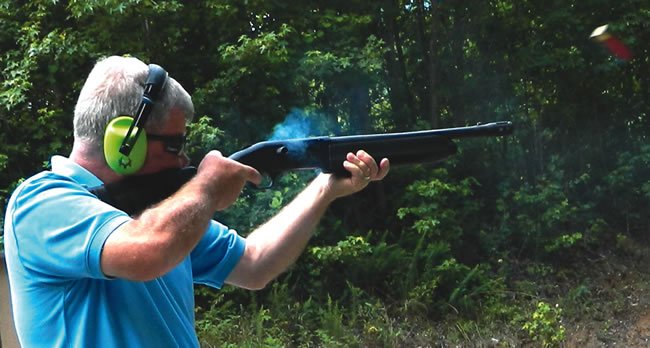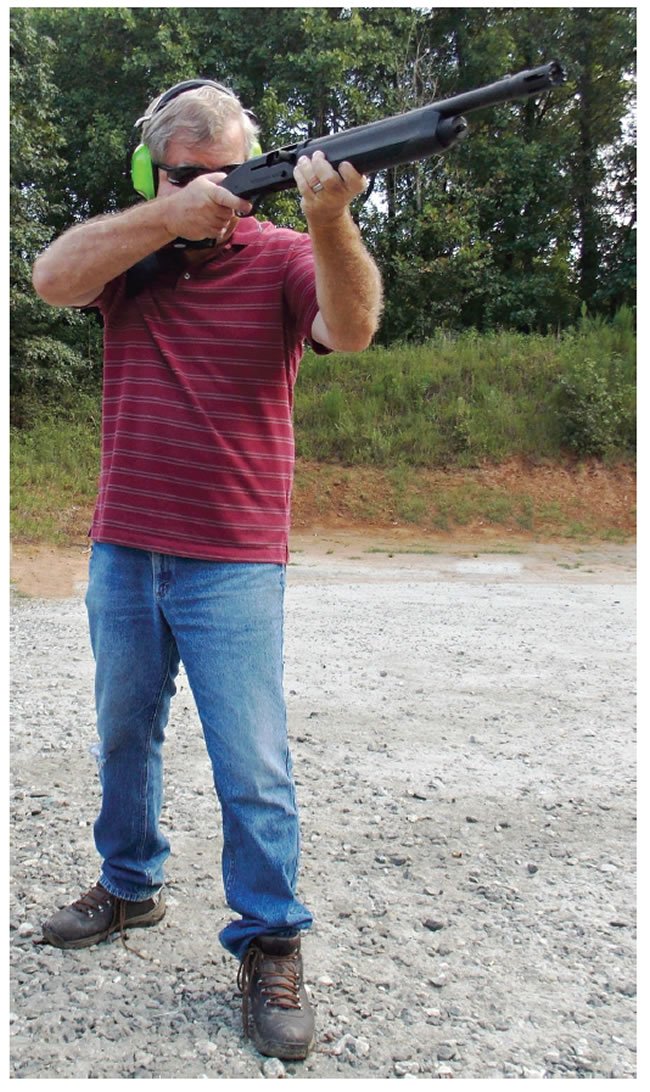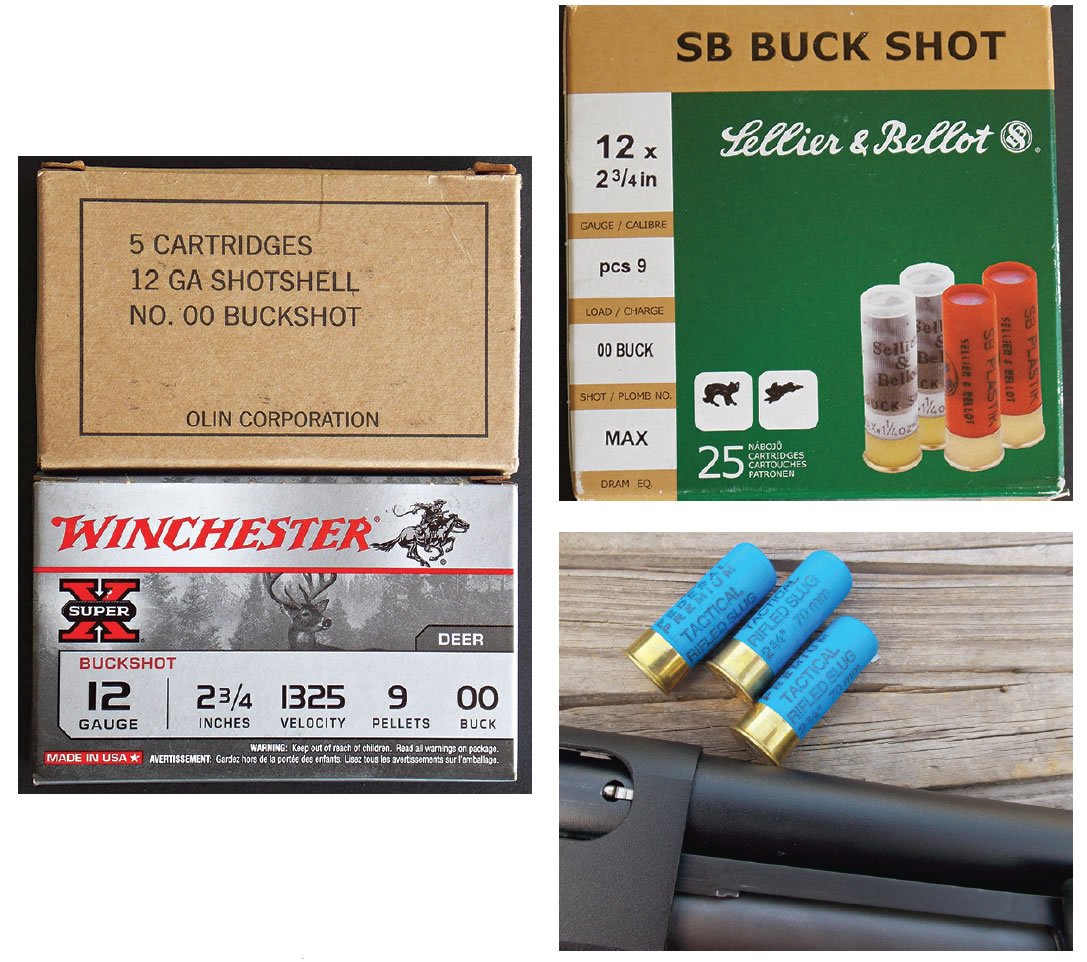
In the scheme of things, the defensive shotgun is the problem solver for homeowners, ranchers, ship captains, zookeepers, and anyone in need of decisive stopping power. In personal defense, area defense, and defense against animals, the shotgun reigns supreme. Powerful, effective, and versatile, the 12-gauge shotgun is an awesome defensive tool. The question is often whether the self-loader is the better choice, particularly since most of us use self-loading handguns and rifles. In this test we put two well-known and popular brands, Remington and Mossberg, to the test. We fire a version of Big Green’s most popular service-grade pump-action shotgun — the Remington 870 — against the Mossberg 930 self-loading shotgun.

There are important differences and similarities between the shotguns, other than the operating systems, self-loading and manual. Each featured plastic furniture and bead front sights. Each was drilled and tapped for an optical sight.
Both shotguns produced similar patterns with Federal, Remington, and Winchester 2-inch full-power 00 buckshot loads. There was no difference in the patterns worth mentioning when the guns were fired at 7, 10, and 15 yards. Reduced-recoil WinLite loads showed the best pattern at short range, as they often do, while Federal Magnums began to show an advantage at 15 yards. We also fired a limited number of slugs and learned that the Remington fired to the point of aim with Federal slugs at 10 yards.
The Remington was simple and rugged, but the 930 was also a capable and effective choice. In the end, a single feeding bobble separated the pair:
Remington 870 ExpressTactical Pump Action 81200 12 Gauge, $442
The price reflects what this firearm cost at CheaperThanDirt.com at the time of our test. The Remington 870 Tactical Model was supplied with a black synthetic stock and forend, a plastic trigger assembly, a six-round magazine, a bead front sight, and a muzzle brake that Remington calls a tactical choke. There is a slightly less expensive variant without the tactical choke. The 81198 version features rifle-like sights. The version tested features a receiver drilled and tapped for scope mounts. On an all-round defensive shotgun, the bead front sight did not bother us at all; in fact, we found it is ideal for fast pointing at close-in targets.
Pointed teeth around the end of the muzzle brake were similar to the special door-breaching-braked shotguns used by the military. These jagged edges are intended to tear into a wooden door, break windows, and otherwise damage stuff, and the ports stabilize the muzzle during rapid firing. The synthetic buttstock featured stippling at the grip that made for good adhesion. The synthetic forend looked skimpy compared to wide wooden forends, but it fit all our hands well and performed well in all testing with all raters. The Remington’s dual action bars gave good, smooth cycling.
The safety was located at the rear of the trigger guard, and its operation was positive and sure. The raters were split in their preferences between this safety and the Mossberg’s tang-mounted safety. The Remington’s safety location was easily manipulated by the shooter. However, it was more difficult to return to the Safe position than the Mossberg. On the Mossberg, the thumb solidifies the firing grip, but on the Remington, the firing grip is broken to place the Remington on Safe. Despite the best attempts of the raters to pick a winner, neither safety proved faster to engage or disengage. However, the Remington was more difficult by a small margin to place back in the Safe position. Tactically, this isn’t particularly important.
As we have done for some time, we began the test with Winchester birdshot, just to get the feel of handling the shotgun. The six-shot tubular magazine was easily loaded. We progressed to firing a mix of buckshot loads. We did not rate the Remington superior to the Mossberg due to its six-shot magazine, because we could have ordered the Mossberg with an extended magazine. We simply chose the model that was available. Two more shells were nice to have, however, so factor that into your choice if you go with the Mossberg.
Our Team Said: The 870’s 18.5-inch-long barrel handled quickly in close quarters with both reduced-power buckshot loads and full-power loads. Recoil was what we expected with full-power buckshot, but it wasn’t harsh. There were no shooter-induced malfunctions, no short cycles, and no problems of any type.

Mossberg 930 TacticalSpecial Purpose Semi-Auto 85330 12 Gauge, $544
The price reflects what this firearm cost at CheaperThanDirt.com at the time of our test. The Mossberg 930 is a gas-operated self-loading shotgun. The 930 featured a black synthetic stock, bead front sight, and tactical-design muzzle brake/choke.
In early use, we found the cocking handle to be well designed for tactical firing. Loading the four-shot magazine wasn’t a chore, and grasping the handle and quickly racking the action wasn’t difficult. The grip gave good purchase, and the forend, which was slightly wider than the Remington’s, felt good in the hand and gave our testers good control.
The Mossberg cannot cycle with less than full-power ammunition, so we used a combination of Winchester and Federal 00 buckshot for most of the testing. One of the raters added a box of Sellier & Bellot loads, and these functioned fine as well.
As noted above, the position of the Mossberg 930 safety lever received good marks. Standing with the shotgun at low ready, it was easy to put the safety on Fire and address multiple targets in one smooth motion. We also noted the trigger reset was crisp and short, which allowed the 930 to slightly outpace the Remington in rapid-fire drills.

During rapid fire, we also noted that recoil was also slightly less, due in part to the gas-fed action operation and in part to the Mossberg’s quarter pound of extra weight. We happily fired the Mossberg and noted that it patterned well, and our test team’s overall the impression of the shotgun was excellent.
Each shotgun was new in the box when we started, but we always clean and lubricate test firearms so we know their initial state is the same. We had run the Mossberg with just over 100 shells, noted that it had done well during several range sessions, so we cleaned and lubricated it and returned it to the safe — one of the raters was going to use it as his truck gun after the last range excursion. Before handing it over to its future owner, at the beginning of what we had determined would be the last magazine we’d shoot in it, we had a malfunction. We fired a single shell, and the shotgun stopped operating. We thought, at first, it was a double feed, but examination showed the first shell was not ejected. The fired casing had been pulled from the chamber, so the failure was not ammunition related, but the extractor appeared to have lost its hold on the shell. The bolt returned to the rear and locked in place. The next live shell was tied up under the fired shell that failed to eject.
Our Team Said: When comparing shotguns, reliability comes before everything else. The Mossberg’s single FTE did not meet the reliability standards of the Remington. You may decide this isn’t important, but we cannot dismiss this malfunction that came well after break in was done. Also, the Mossberg requires high-performance shells to function, and this may make it unsuitable for a shared weapon for home defense. It isn’t pleasant to fire full-power buckshot loads for most shooters. The Remington functions with any type of load, including light birdshot loads, full-power buckshot, or reduced-recoil 12-gauge buckshot loads originally developed for law-enforcement use. In the end, the Remington is a Best Buy compared to the Mossberg, in our view. With the 870 Tactical, we saved a hundred-dollar bill and got better reliability.
Written and photographed by R.K. Campbell, using evaluations from Gun Tests team testers.





























